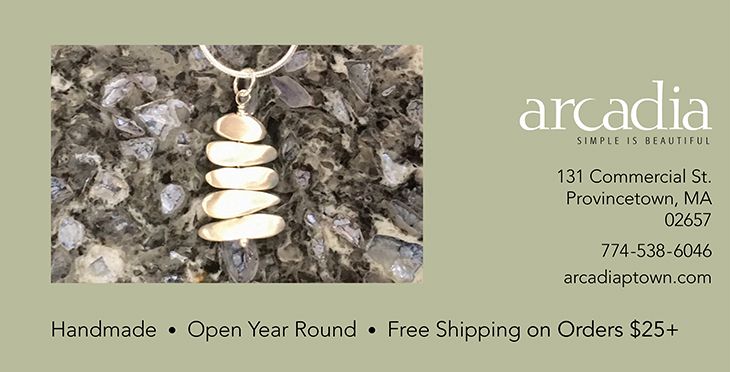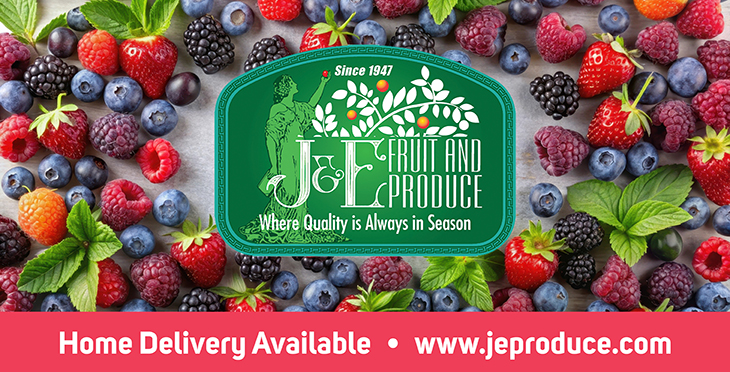The dirt road to Alexa Elam’s Truro studio is bumpy and surrounded by brush, with a few pullouts for oncoming cars to pass, and marked only by a hand-painted sign on a piece of salvaged wood.
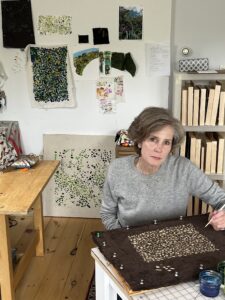
She’s found the right setting for her work, it seems.
Elam is a textile artist whose work is often landscape-based, though it doesn’t always depict her immediate Outer Cape surroundings. Landscapes also occupy her memories.
Two recent pieces recall her past in Brooklyn, where a red smokebush grew in an empty lot she’d pass on her way to her Red Hook studio. These were among the pieces she showed in April at the Higgins Gallery at Cape Cod Community College — the first time she’s showed her work on the Cape.
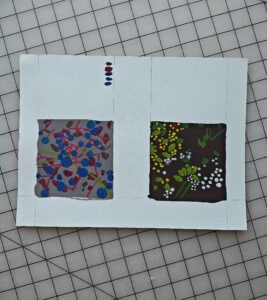
In one of them, Elam uses layer upon layer of tiny seed stitches to capture the “smokiness,” the visual softness, of the bush. The other rendition is in appliqué and manages to be both naturalistic and abstract. What a modernist painter would do with brushstrokes, Elam achieves on her own terms, with color and the simple truth of her medium: thread and pieces of fabric.
Her workspace here is large and light-filled — windows look out onto a wooded lot. There are fabrics in bolts and stacks, a sewing machine with a thread rack nearby, an iron, a workbench with a cutting mat, and a large loom. Shelves of books are at hand, too, their subjects wide-ranging and often visual: the paintings of Pierre Bonnard, the experimental woven sculptures of Sheila Hicks, the quilts of Gee’s Bend, fashions of Comme des Garçons, gardens, and a biography of Virginia Woolf’s sister, Vanessa Bell.

“I love to sew,” Elam says. She grew up in Richmond, Va. in a household that valued the arts, and her mother was a seamstress. “I learned from my mom, but I learned my own way, too.” She designed her own clothes and still does.
But Elam veered away from turning that craft into a career. She studied textiles at Virginia Commonwealth University, then added weaving, printmaking, and dye technology at the Worcester Center for Crafts. But she worried about what might happen after graduation: “I didn’t want to go to work for a company where they would tell me, ‘Oh, today you’re going to design fabric with roses,’ or ‘Today, you have to make plaids.’ I wanted to be free to do what I wanted to do.”
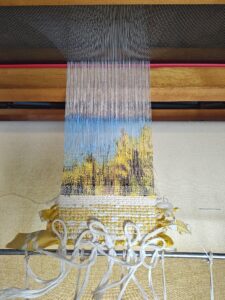
Changing course, she finished college as a history major at UMass Amherst and went on to jobs unrelated to art. But in Amherst she met her husband, Tim Pearson, a painter. Pearson’s mother is Truro artist Rosalind Pace, and family visits here laid the groundwork for their move in 2021.
An Outer Cape landscape turns up in Winter Woods. It’s based on a drive on Route 6 on a snowy day in late spring. Trees had started leafing out, but the oaks still held their old leaves. She is one to notice the details. “We have so many different varieties of oak here,” she says. “Some of the leaves are red, some are orange, some are brown, and some are amber-colored.”

The piece captures the interplay of leaves, tree trunks, and snow, with translucent textile dyes painted on velvet — a new technique Elam has been experimenting with. She stretches the velvet and works flat, painting from light to dark, and in this piece, the white of the velvet fills the pictorial field. Disjointed tree trunks suggest the movement of windswept snow and of the car passing by. Flecks of green, brown, and pale yellow compete with the white, confounding the figure-ground relationship, like real snow falling.
She chose velvet because of its texture and tooth and how it soaks up dye. She’s tested different fabrics of varying weights. Painting on silk — and to an extent on cotton as well — favors circles, she says, because of how the dye spreads.

Such tests, or studies, are necessary. Unlike paint on canvas, which can be scraped or sanded off, there’s no going back when painting with dyes on material. “You need the courage of your convictions with this,” Elam says.
Photography is part of her process. Elam often starts with a photo she took while walking or as a passenger in a car. She’ll then make a painting of the photo in gouache, which is the jumping off point for a more fully realized work. Taped to her loom is a slightly blurry photo she took from a car. “I just love the feeling of the motion and the light and the landscape and the trees,” she says.
Elam has been searching for a way to render this type of image, and right now there’s an attempt underway on her loom. She has painted the warp with textile dye and has been weaving with different colors of sewing thread. The approach is based on the dyed warp technique used for fabrics like ikats that have blurry designs.
There are questions here. The warp is cotton, but it’s fuzzy and she’s not certain about that. And how close together should the threads of the warp be? How did the dye take?
Elam is mid-experiment, and she likes it that way: “I’m excited about this because it feels like there are a lot of possibilities.”
